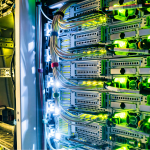The era of hyperscale data centers is upon us

- Hyperscale companies are breaking all spending records, spurred by business models that have actually benefited from the pandemic
- In 2020 alone, more than 100 new hyperscale data center facilities were built
- By 2022, the hyperscale data center market will grow to US$80 million – mostly within the Asia Pacific region
In most industries across the globe, the Covid-19 pandemic has been a bane but for hyperscale data center operators, it was the total opposite. Demand for cloud and digital services has skyrocketed since 2020 following the spike in the need for secure and reliable data centers — considered by many as the hubs of modern enterprise data storage. All of which was critical since early 2020, when it became important to support work- and learn-from-home initiatives across the globe.
As a result, the capital expenditure spending on hyperscale data centers by the 20 largest cloud and internet service companies in the world hit a record-breaking US$37 billion in the third quarter of 2020. Data centers spending by these companies from January 2020 to September 2020 totaled US$99 billion, up 16% year-on-year (YoY).
What is a hyperscale data center?
As with many new concepts in the information technology (IT) era, there’s no agreed-upon definition for what makes a data center hyperscale. The International Data Corporation (IDC) provides research and advisory services to the tech industry and classifies any data center with at least 5,000 servers and 10,000 square feet of available space as hyperscale.
But the Synergy Research Group focuses less on physical characteristics and more on “scale-of-business criteria” that assess a company’s cloud, e-commerce, and social media operations.
Rising hyperscale data center need
To give an idea of how substantial the pandemic was for the data center industry, according to a new report from Synergy Research Group, in 2020 alone, more than 100 new hyperscale data center facilities were built, taking the total number to almost 600. The research firm found that the total number of large data centers operated by hyperscale providers increased to 597 at the end of 2020, and has more than doubled since 2015.
Synergy reported 430 hyperscale facilities in 2018, which grew to 500 in 2019. Amazon, Microsoft, and Google collectively account for over half of all major data centers and continue to be significant drivers of growth. Amazon and Google opened the newest data centers in the last twelve months, accounting for half of the 2020 additions. Synergy added that Oracle, Microsoft, Alibaba, and Facebook were also active last year.
YOU MIGHT LIKE

Will data center sustainability take priority in 2021?
Chief analyst John Dinsdale said there were 111 new hyperscale data centers opened in the last eight quarters, with 52 of those coming on-stream in 2020 despite Covid-19 causing a few logistical issues. “That is testament to the ongoing robust growth in the digital services that are driving those investments – particularly cloud computing, SaaS, e-commerce, gaming, and video services.”
The Economic Times quoted PayU’s CTO Shantanu Preetam who believes that the global pandemic actually spurred a record-breaking quarter for hyperscale data centers. “Digital growth and acceleration are here to stay and grow. And with that reality, there is more and more need for leaders like us and all out there to embrace the technology and trends which will give organizations a competitive advantage. All of this will add to more and more demand for data centers and cloud infrastructure.”
In short, the increasing demand for cloud computing infrastructure and IoT functionality will continue to drive the need for data centers of all kinds. Hyperscale facilities offer a unique combination of energy efficiency and functionality that will likely make them the preferred choice of data storage facility for most companies.








